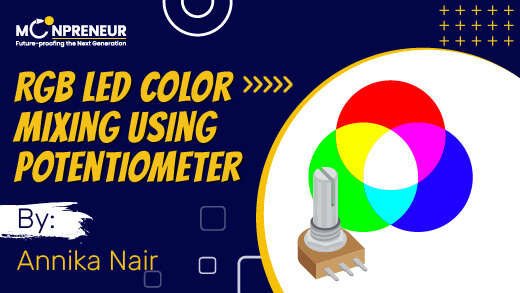MoonCampaign by Annika (11 years)

RGB LED Color Mixing Using Potentiometer
Annika Nair
Show n Tell
Show n Tell
Coming Soon
Annika Nair's "RGB LED Color Mixing Using Potentiometer" project uses simple components like a potentiometer, RGB LED, and a coin battery to demonstrate color mixing without programming. By adjusting the potentiometer, Annika controls the intensity of the red, green, and blue LED components, creating a range of colors through additive color mixing. This hands-on project offers an easy introduction to electronics and color theory, providing insights into how basic circuitry can mimic the color blending techniques used in displays and lighting systems.
Color mixing has always intrigued me, especially how primary colors combine to form a spectrum of hues. My project, "RGB LED Color Mixing Using Potentiometer," explores this concept using simple components like a potentiometer, a coin battery, and an RGB LED, all without any programming. By adjusting the potentiometer, I could manipulate the intensity of the red, green, and blue elements of the LED, effectively creating different colors.
The potentiometer acts as a variable resistor, controlling the amount of current supplied to the RGB LED. Depending on its position, the brightness of each color component (red, green, or blue) changes, resulting in the blending of colors. By carefully adjusting the potentiometer’s knob, I could create shades of purple, cyan, yellow, and even white when all colors mixed at full intensity. This hands-on experiment showed how simple circuitry could mimic the concept of additive color mixing seen in displays and lighting systems.
The simplicity of this project makes it a great educational tool for understanding electronics and color theory. It’s ideal for beginners looking to explore basic circuit design and the interplay of current and light. Seeing the vibrant colors blend seamlessly inspired me to think about how these principles are applied in real-world technologies like LED screens and mood lighting systems.
©️ Copyright, Moonpreneur Inc.
3031 Tisch Way, 110 Plaza West PMB # 138, San Jose, CA 95128, USA
Likes
Rating
62 days left
RGB LED Color Mixing Using Potentiometer